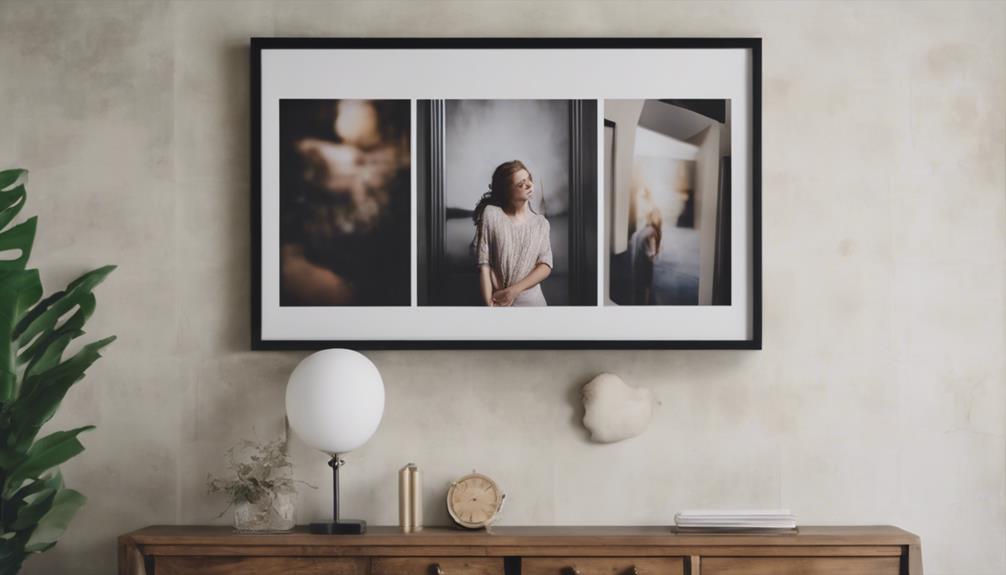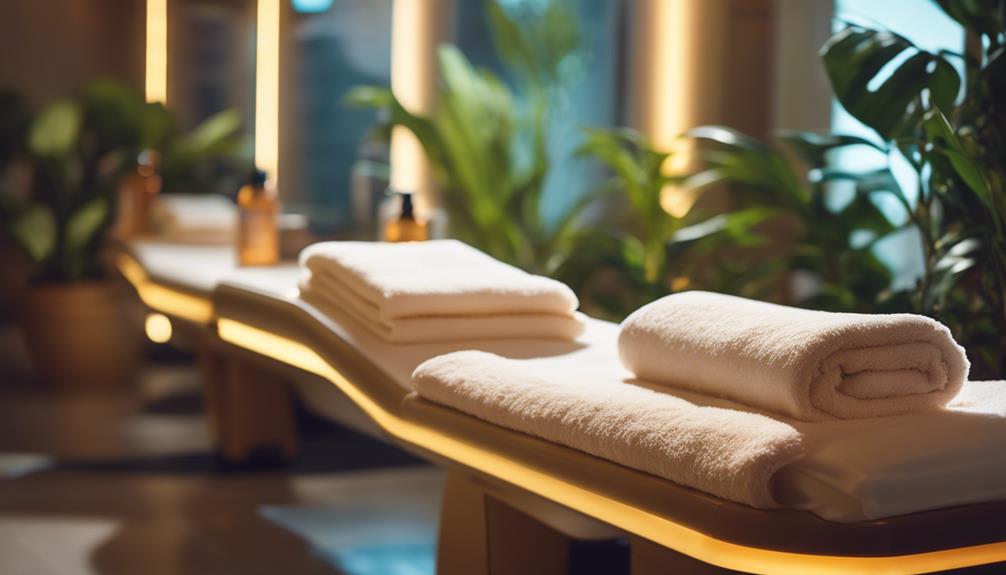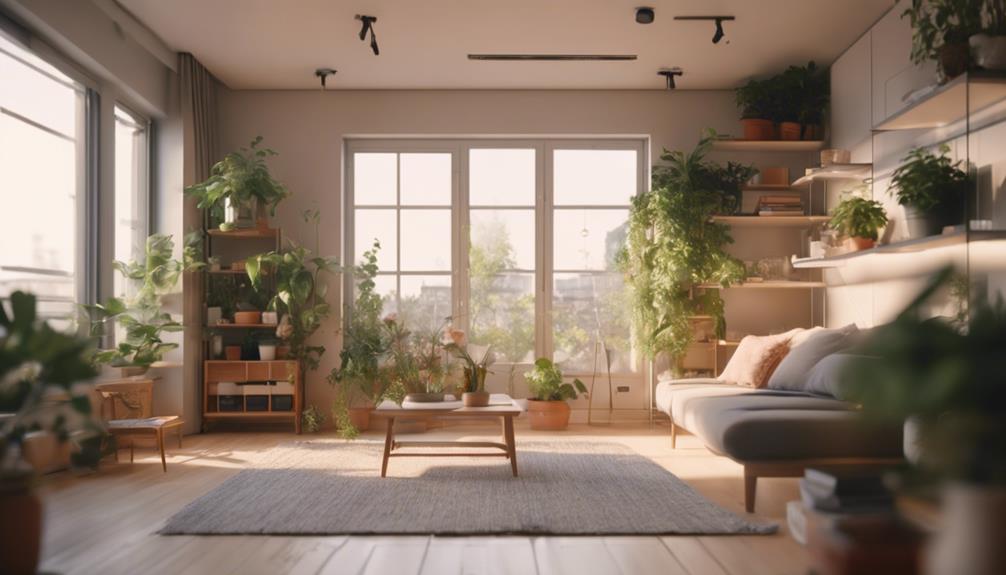To achieve the perfect home decor, it is recommended to hang artwork at eye level (57-60 inches from the floor) for ideal viewing. You may need to adjust this based on the average height in the room and consider furniture placement. By doing so, you can guarantee comfortable enjoyment for everyone and maintain an eye level connection with the art. For a cohesive look, take into account architectural features, artwork size, placement, and lighting. Enhance your space by supporting local artists and investing in quality frames. Following these expert tips will help you transform your home into a masterpiece with precise art placement. Start mastering the art of home decor by following these fundamental steps.
Key Takeaways
- Hang artwork at eye level for optimal viewing.
- Consider furniture height for proper placement.
- Use quality hanging hardware for secure display.
- Select art that fits wall dimensions and budget.
- Support local artists for unique pieces.
Hanging Artwork at Eye Level
For best visual impact, hang artwork at eye level, typically around 57-60 inches from the floor. When you place art at eye level, it ensures that you can fully engage with and appreciate the pieces on your wall.
Adjust the placement based on the average height of people in the room to guarantee that everyone can enjoy the artwork without straining their necks. Taking into account furniture height is also vital. If you have low furniture, you might need to hang the art a bit lower to maintain that eye level connection. Conversely, if you have tall furniture, you may need to adjust the art higher on the wall.
Proper Lighting Placement
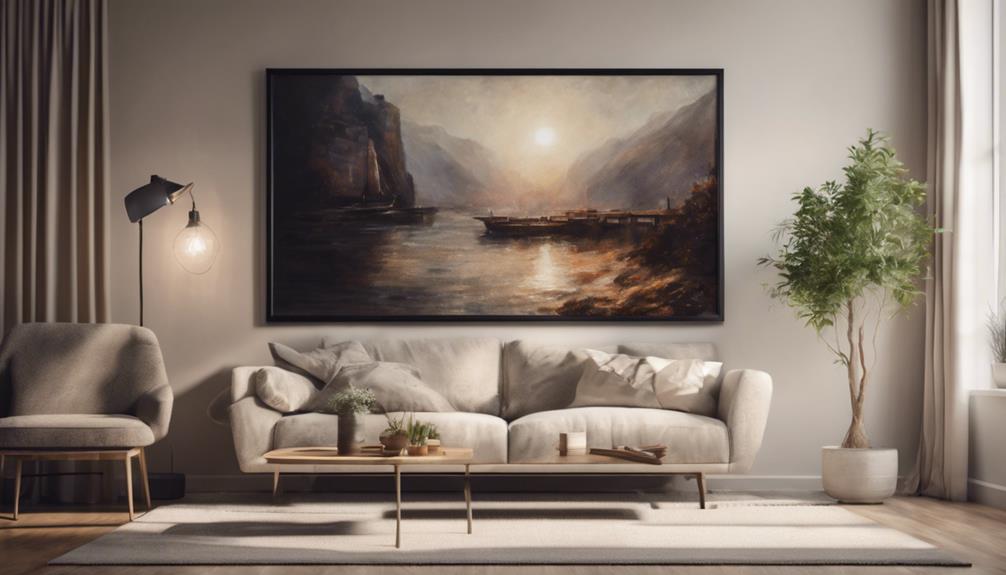
When it comes to illuminating your artwork, proper lighting placement is key. Make sure your lighting fixtures are positioned correctly to avoid casting unwanted shadows or distortion.
Remember to place lamp shades at eye level or slightly above when seated for the best visual impact.
Optimal Lighting Positions
Positioning your accent lights at eye level or slightly above can effectively highlight your artwork.
Pendant lights should be hung at the right height to prevent glare on your pieces.
When using track lighting, make sure it's positioned correctly to illuminate your art evenly without casting unwanted shadows.
Wall sconces can be placed at or above eye level to complement larger art pieces beautifully.
For a more focused approach, consider incorporating adjustable spotlights to direct light precisely onto your artwork, enhancing its display.
By strategically placing your lighting fixtures, you can create the perfect ambiance to showcase your art while adding depth and dimension to your space.
Remember, the key is to balance the brightness and direction of the light to bring out the best in your artwork without overpowering it.
Experiment with different lighting positions to find what works best for each piece and watch as your art truly comes to life in your home.
Eye-Level Lamp Placement
To guarantee proper illumination for reading or tasks, place your lamps at eye level or slightly above when seated. Correct lamp placement ensures that the light is directed where you need it most without causing glare or shadows. By positioning your lamps at eye level, you create an ideal lighting environment that enhances visibility and comfort in the room.
When considering lamp placement, be mindful of the type of lighting you want to achieve. Lamps at eye level provide direct task lighting, perfect for activities like reading or working on a computer. Additionally, proper lamp shade placement helps distribute light evenly, preventing harsh shadows and creating a warm, inviting ambiance in the space.
For ambient lighting, consider pendant lights and chandeliers hung at the appropriate height to illuminate the room effectively. Sconces, on the other hand, should be placed at or above eye level to provide ambient lighting and enhance the overall atmosphere of the room.
Sconce Spacing Guidelines
For balanced lighting coverage in a room, make certain sconces are spaced 6-8 feet apart. Proper sconce spacing guarantees even illumination without creating harsh shadows. Consider the size and purpose of the room when determining the placement of your wall sconces. Mount the sconces 60-72 inches from the floor for best lighting distribution, keeping in mind eye-level comfort for those in the space.
To achieve symmetrical lighting, install sconces on either side of a focal point, such as a fireplace or piece of wall art. This arrangement not only provides balanced illumination but also enhances the visual appeal of the room.
Additionally, utilizing dimmer switches allows you to control the brightness of the sconces, helping to create different moods and ambiance in the space.
Ideal Rug Size Selection
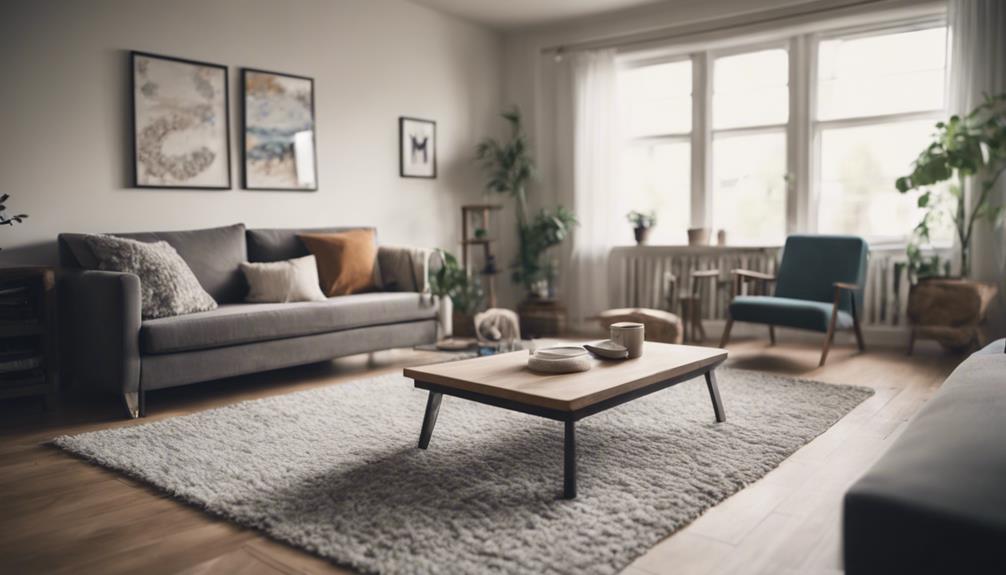
When selecting a rug for your space, keep in mind that the size plays a vital role in connecting the room. Make sure it's large enough to fit under key furniture pieces for a cohesive look.
The right rug size can impact furniture placement and define separate areas within a room.
Rug Size Basics
Take into account the sizing of your rug 2-3 feet smaller than the room's dimensions to create a border of flooring around it for a balanced look.
When picking a rug for your living room, aim for one that's large enough for all furniture legs to sit on it, or at least the front legs of larger pieces like sofas.
In a dining room, select a rug that's 24-30 inches larger than the table on all sides to guarantee chairs can remain on the rug when pulled out.
For bedrooms, extend the rug at least 18-24 inches beyond the sides of the bed to provide a soft landing spot for your feet.
It's important to take into account the room layout and the rug's purpose to choose the right size for a harmonious and visually appealing interior design.
Furniture Placement Impact
Consider the impact of furniture placement when selecting the ideal rug size to guarantee a cohesive and well-balanced room design. Here are three key points to keep in mind:
- Room Size Matters: Take into account the dimensions of your room when choosing a rug size. A small rug in a large room can make the space feel disconnected, while a rug that's too large in a small room can overwhelm the area.
- Furniture Layout: Make sure that the rug accommodates your furniture layout. In the living room, for example, all the furniture legs should ideally sit on the rug or at least have the front legs on it to tie the seating area together.
- Enhancing the Design: Proper rug sizing can enhance the overall design of the room. It can create a sense of unity, define different zones within a room, and add a layer of coziness and style to your space.
Curtain Rod Measurement Tips
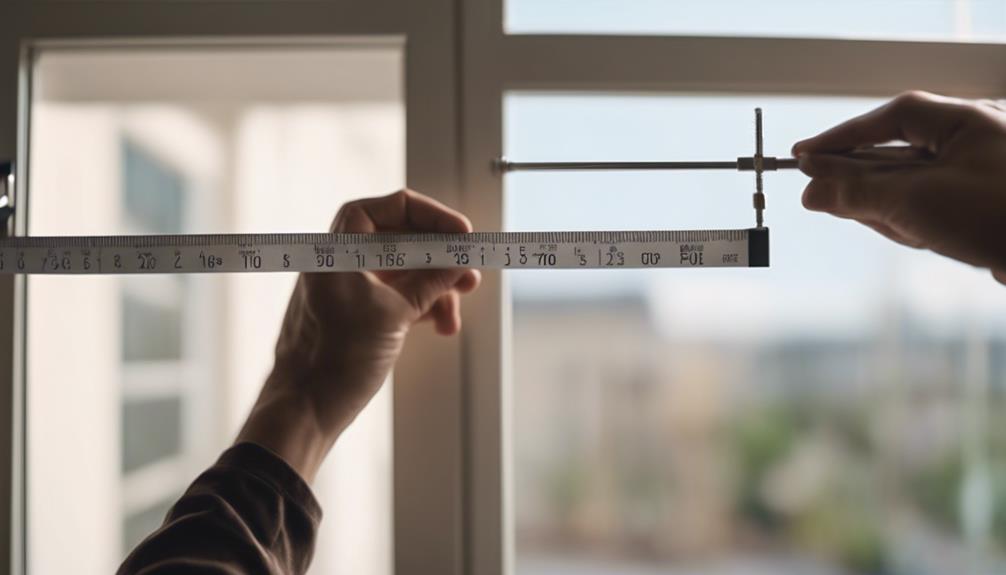
To determine the appropriate curtain rod size, start by measuring the width of your window. Add additional inches on each side of the window frame for the curtain rod to extend beyond. Take into account the curtain panel width and fullness for proper coverage and aesthetics. For a layered look, make sure the curtain rod is long enough to accommodate multiple panels. Select a curtain rod length that complements your window size and desired curtain style.
| Curtain Rod Measurement Tips | |
|---|---|
| Step 1 | Measure window width. |
| Step 2 | Add additional inches. |
| Step 3 | Consider panel width. |
| Step 4 | Choose rod length. |
Following this guideline will assist you in creating a balanced and visually appealing window treatment. Keep in mind that the curtain rod should not only fit your window but also enhance the overall look of the room.
Perfect Picture Hanging Height
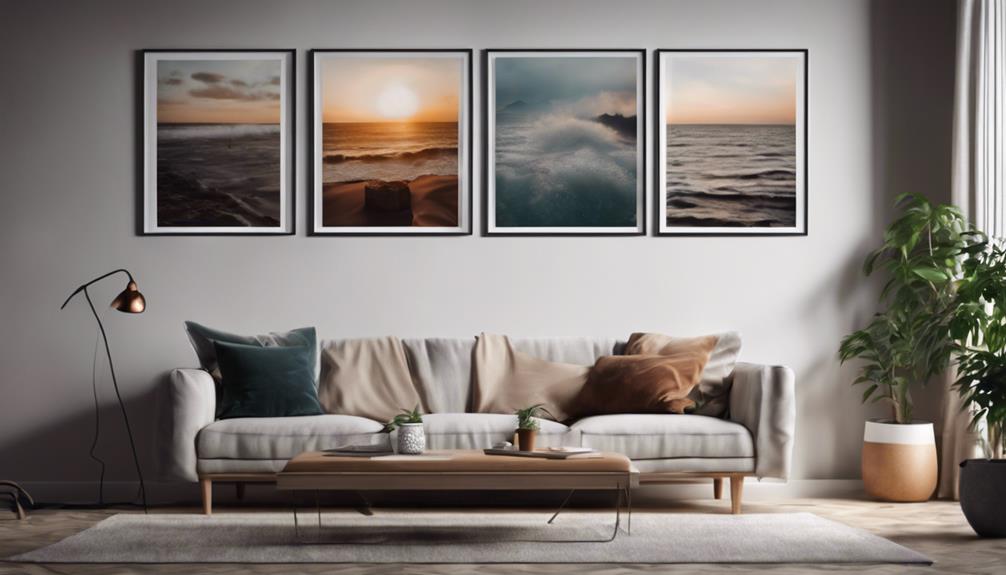
For a well-balanced room, aim to hang your artwork at eye level, typically between 57-60 inches from the floor for best viewing. When determining the perfect picture hanging height, consider the following:
- Eye-Level Placement:
Hanging your art at eye level guarantees that it's easily visible and can be appreciated without straining the neck. This height range is commonly recommended for most spaces.
- Art Piece Scale:
Take into consideration the size and scale of your art piece. Larger pieces may require a slightly lower placement to maintain visual balance, while smaller pieces can be adjusted higher without losing impact.
- Room Specifics:
Adjust the hanging height based on individual preferences and the room layout. Consider the surrounding furniture and architectural features to make sure the artwork harmonizes with the overall space.
Mastering Art Scale
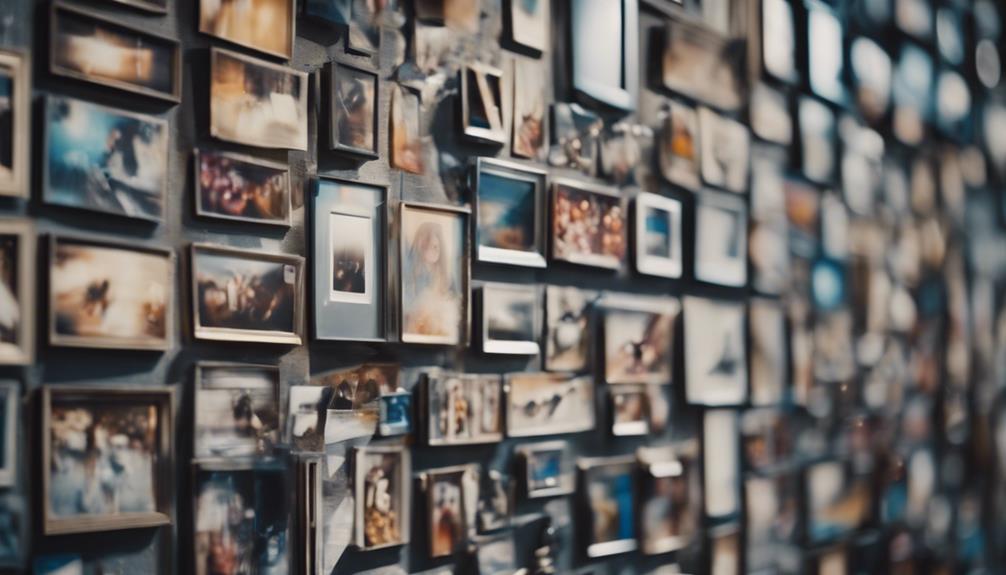
Achieving the correct scale for your artwork is crucial in mastering the impact of your wall decor. The scale of your artwork should align with the size of the wall or space it adorns.
For large empty walls, opt for bigger art pieces to establish a focal point and maintain visual balance. When placing artwork above furniture, aim for it to occupy at least half to two-thirds of the width to uphold the appropriate scale.
Whether you choose a single art piece or a grouping, make sure they're substantial enough to command attention in the room. Select artwork that effectively fills up the wall space to enhance the overall aesthetic and design impact.
Hanging Artwork With Confidence
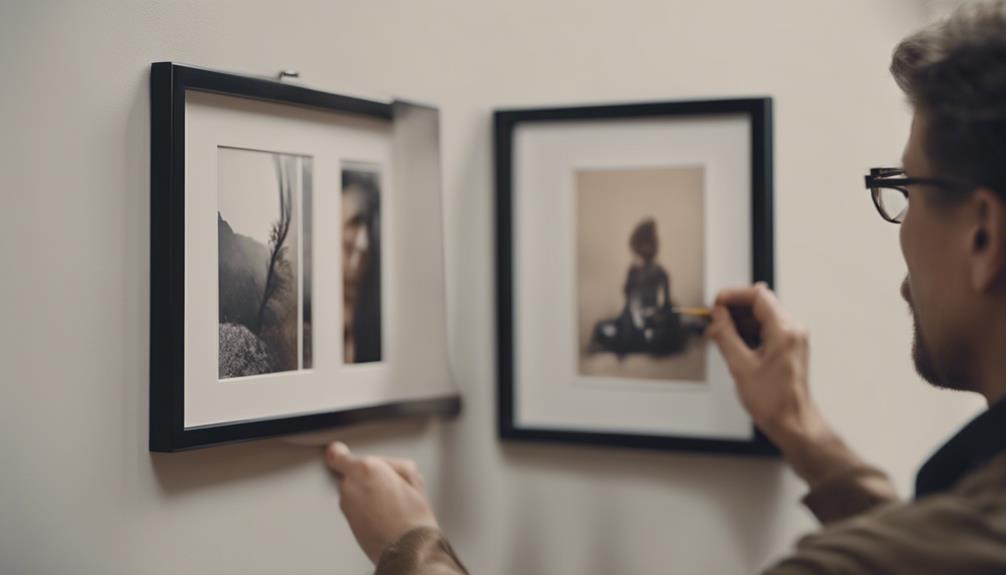
Hang your artwork with confidence by positioning it at eye level, tailored to your height and furniture arrangement. When hanging your pieces, remember these key points: Make sure to use the right hardware for the weight of the piece and to use a level to ensure it is straight. Additionally, if you’re looking for some inspiration, consider incorporating home decor ideas with photo frames to add a personal touch to your space. Displaying your favorite photos in stylish frames can create a personalized and inviting atmosphere in your home.
- Adjust Height for Best Viewing:
Aim to hang your artwork so that the center is at eye level, typically around the 57-inch mark on the wall. This ensures that the piece is easily seen and appreciated.
- Maintain Distance from Furniture:
Keep a distance of 4-8 inches between the bottom of the artwork and the top of furniture like sofas or tables. This helps in creating a cohesive look and prevents the two from visually clashing.
- Consider Architectural Features:
Take into account any architectural elements such as molding or wainscoting when determining where to hang your art. Make exceptions to standard rules if necessary to ensure the piece complements its surroundings seamlessly.
Artwork Sources and Tools
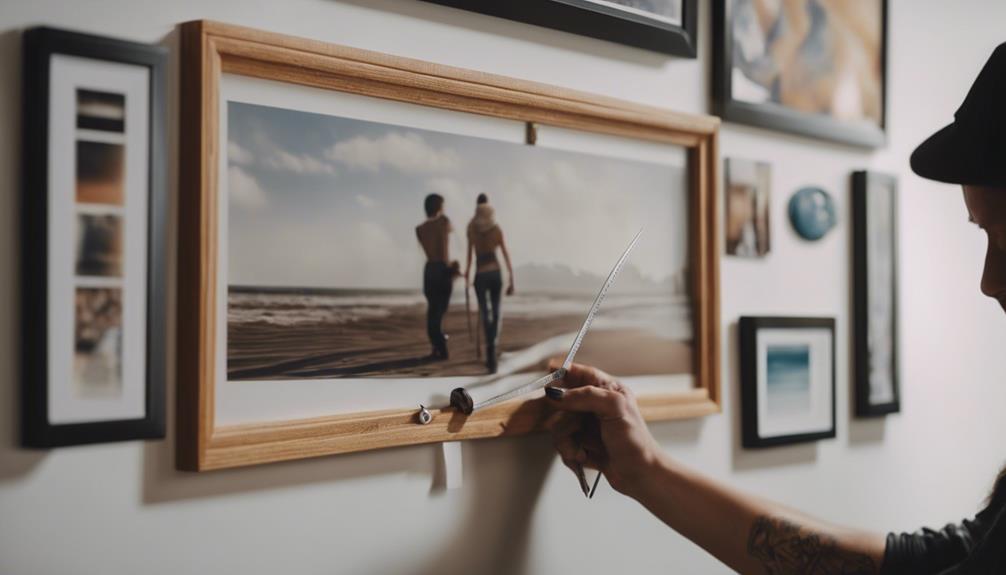
When sourcing artwork for your home decor, consider commissioning local artists for a unique touch.
Explore online platforms like GreatBigCanvas.com and Art.com for a wide variety of art prints in different sizes and frames.
Remember to invest in original pieces if possible to add a special and personal flair to your space.
Art Sources and Options
Consider supporting local artists by commissioning original artwork for a personalized touch in your home decor. When sourcing art for your walls, explore a variety of options to find pieces that speak to you:
- Look into online art companies such as GreatBigCanvas.com and Art.com for a vast selection of art prints that cater to different tastes and styles.
- Invest in original artwork if your budget allows, as it can add a unique and high-quality touch to your space, showcasing the artist's craftsmanship and creativity.
- Explore custom framing options to enhance the visual appeal of your art pieces and guarantee they seamlessly blend in with your existing decor. Custom framing can elevate the overall look of your artwork and make it a focal point in any room.
Essential Hanging Tools
To properly hang your artwork and enhance its visual impact, equip yourself with essential tools such as mini levels, plate hangers, and tack hammers. These tools are pivotal for achieving precise art hanging and ensuring that your art pieces are securely and accurately displayed.
When it comes to hanging hardware, investing in quality materials is key to supporting the weight of your art and keeping it safely mounted on your walls. Quality frames not only complement your art pieces but also contribute to the overall aesthetics of your home decor.
Whether you have commissioned original art or purchased prints from online companies like GreatBigCanvas.com or Art.com, using the right tools for hanging will help you showcase your art in the best possible way.
Remember that the proper tools and hardware are essential for creating a visually appealing display while also protecting your walls from unnecessary damage.
Artwork Size Considerations
Invest in original art pieces to add a unique touch to your home decor and choose from a wide selection of art prints in various sizes and frames available from online companies like GreatBigCanvas.com and Art.com.
When considering the size of artwork for your space, keep these points in mind:
- Pricing Factor: The cost of art is often influenced by its size, so select pieces that fit both your budget and the dimensions of your walls.
- Support Local Artists: Commission personalized artwork to not only enhance your home but also support the creativity of local artists, ensuring a one-of-a-kind addition to your decor.
- Utilize Hanging Tools: To hang your artwork securely and evenly, make use of tools like a mini level, museum putty, and traditional hooks. These tools will help you achieve a balanced display that complements your space effortlessly.
Wall Art Placement Considerations
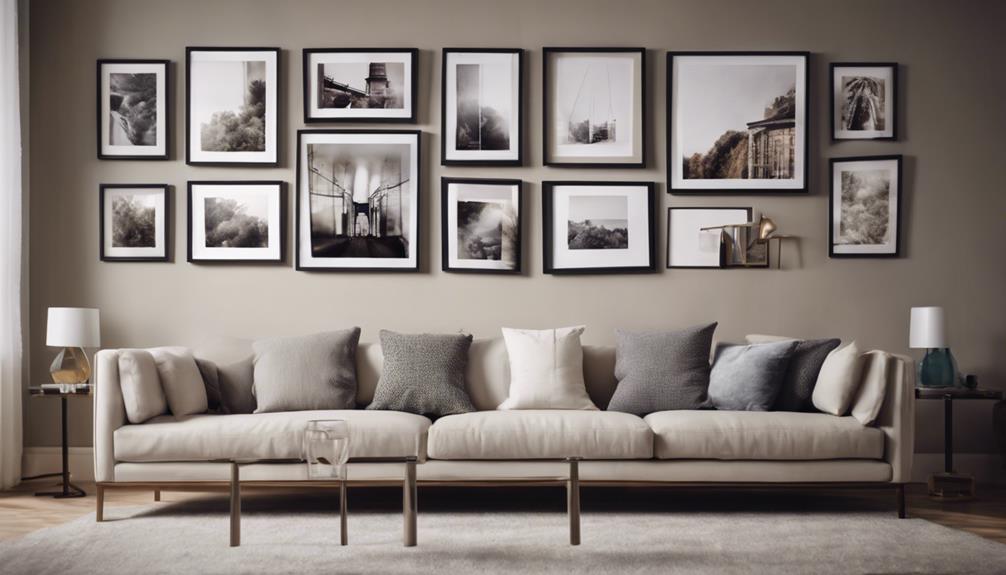
When positioning artwork on your walls, take into account the height of the wall to ensure proper placement. For a large living room, consider the overall design and size of the artwork in relation to the space available. Guarantee that the artwork complements the furniture in the room, creating a cohesive and balanced look.
Take into consideration the natural lighting to avoid glare on the artwork, which can impact its visibility and overall appeal. To create a focal point, position the artwork at eye level for best viewing. Following the 2/3 width rule when hanging artwork over furniture can absolutely help achieve a balanced aesthetic.
Secure Wall Anchors for Art
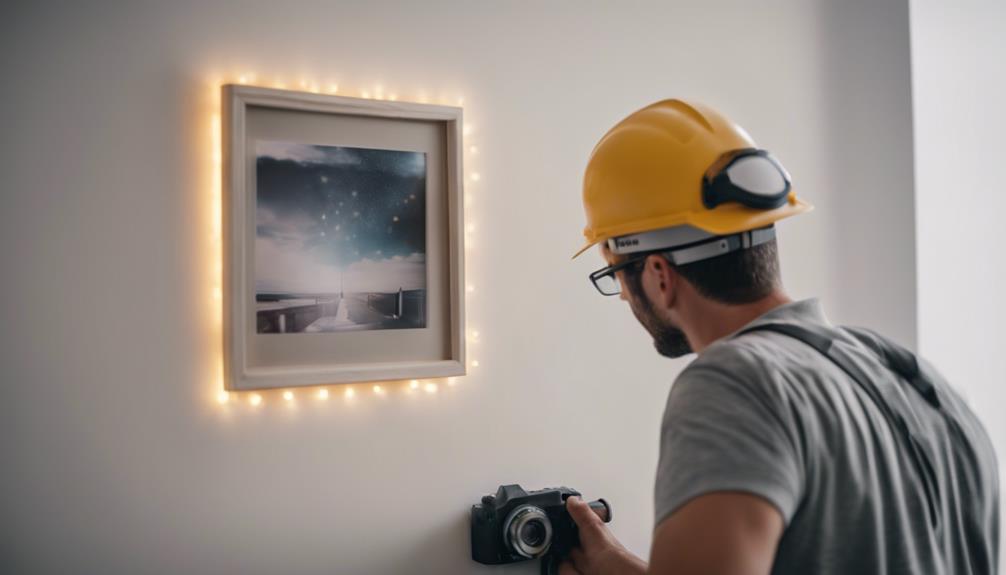
Wall anchors play an important role in securely mounting artwork on various types of wall surfaces. When it comes to hanging art, making sure your wall anchors are secure is vital.
Here are three key points to keep in mind:
- Choose the Right Hardware: Select screws, nails, or anchors based on the weight of your artwork to avoid any accidents. Using the appropriate hardware will help keep your art in place.
- Utilize Proper Tools: Make sure you have the necessary tools like drills, screwdrivers, and levels for accurate installation of wall anchors. Having the right tools will help you achieve a stable and straight display.
- Beware of Hidden Obstacles: Before installing wall anchors, be mindful of any concealed barriers within the walls, such as electrical wiring or pipes. Checking for these obstacles beforehand can prevent damage and ensure a smooth installation process.
How Can I Incorporate Photo Frames into my Wall Art for Perfect Home Decor?
Looking to spruce up your home decor? Learn how to use photo frames to add a personal touch to your wall art. Mix and match different frame styles and sizes for a dynamic display. Create a gallery wall or use a single large frame as a focal point. Experiment with different layouts to find the perfect arrangement.
Conclusion
Now that you have mastered the art of hanging artwork for perfect home decor, it's time to put your skills to the test! Experiment with different placements, lighting options, and sizes to create a personalized and visually appealing space. Consider using photo frames at home to display cherished memories and add a personal touch to your decor. Mix and match frame styles and sizes to create a dynamic and eclectic look. Don’t be afraid to play with unconventional placements and arrangements to showcase your favorite photographs. This will add depth and personality to your walls and make your home feel warm and inviting. You can also use photo frames to create a gallery wall, displaying a mix of family photos, artwork, and other sentimental items. Using photo frames in this way allows you to tell a story and showcase your personal style throughout your home. Whether you prefer a minimalist look or a more eclectic approach, the possibilities are endless when using photo frames to enhance your home decor.
Remember, confidence is key when it comes to decorating your walls. So grab your tools, get creative, and transform your home into a gallery-worthy masterpiece!
